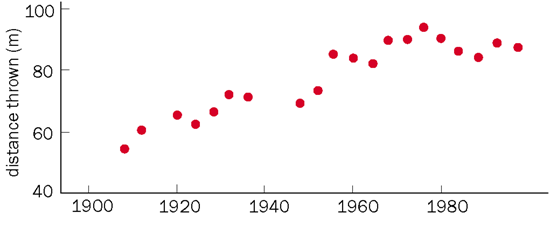Daniel Lenord
University of Alaska Fairbanks
Physics 211 Web Project, Fall 2002
| Index | 100-meter Dash | Javelin | Pole Vault | Bibliography | |
In 1953, a hollow javelin was invented by Franklin Held. Since the javelin has a standard weight, the surface area was increased. This, in turn, increased the javelins flight capability. Another characteristic of this javelin was that it landed horizontally. In 1966 the javelin was thrown over 100 meters (328 feet) by a Spaniard who employed a discus style turn before the throw. This throwing style was deemed unsafe and subsequently banned by the International Amateur Athletic Federation (IAAF). The 100 meter mark was once again broken in 1984. The IAAF then adopted new rules to ensure shorter flight times.
By examining the aerodynamics of the javelin, we will begin to understand how a javelin might be designed to limit the time of flight. First of all, a javelin does not produce lift in the same manner as a discus. As the air travels around the shaft (see figure below) the flow tends to separate on the upper surface. One normally thinks of separation as increasing the drag force. That is what happens here, only the direction of the force is opposite that of the gravitational force. Therefore, the separation of the flow from the upper surface of the javelin actually increases the flight time.

An example of a javelin in flight
The modern javelin is designed such that the center of pressure is behind the center of gravity. This induces a nose down pitching moment, thereby reducing the flight time of the javelin. The location of the center of pressure will vary in flight. However, the center of pressure remains behind the center of gravity and the nose down pitching moment remains throughout the flight.
The nose down pitching moment of the javelin also ensures that the javelin lands point first. A point first landing makes the javelin a safer event as well as making it easier to measure the distance of a given throw. Since the javelin can no longer slide across the ground, there is no question about how far the javelin was thrown. The javelin also experiences a spin about its longitudinal axis during flight. This spin can be as high as 25 revolutions per second. This spin tends to stabilize the javelin in flight. Another phenomena of the javelin in flight is an oscillation about the length of the javelin. This oscillation has a frequency of about 25 hz. The oscillation is detrimental to the flight of the javelin and therefore needs to be minimized by the thrower. This is done by ensuring a delivery which is in the same vertical plane as the flight path of the javelin.

Winning distances in the men's javelin competition at the Olympic games.
